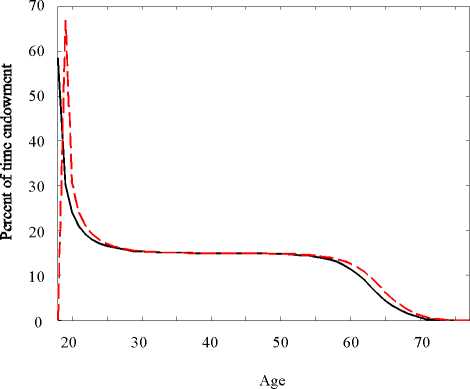and a significant share of their time otherwise would be spent on learning. They
compensate for the initial loss in learning by raising learning efforts in the first
couple of years after conscription. Lifetime income is reduced by the ine∏icienl
allocation of time and the supplementary tax payments during conscription, and
conscripts raise learning efforts late in the life cycle to compensate for the income
loss.
Non-conscripts, on the other hand, marginally reduce their learning period.
The increase in the interest rate reduces the present value of the return to learning
and leads to a reduction in human capital accumulation. Investment in human
capital is also reduced by the decrease in the net wage rate. The reduced net wage
rate leads to an increase in the demand for leisure. Earlier retirement reduces the
amortization period for investment in human capital and leads to less learning.
Hence, the opposite changes in net factor prices both have negative impacts on
learning efforts by non-conscripts.
Figure 3a. Training for conscripts (∙ = 0.25 and * = 0.50)

_____ No draft
__Draft
13
More intriguing information
1. The Composition of Government Spending and the Real Exchange Rate2. Gerontocracy in Motion? – European Cross-Country Evidence on the Labor Market Consequences of Population Ageing
3. PEER-REVIEWED FINAL EDITED VERSION OF ARTICLE PRIOR TO PUBLICATION
4. Nonlinear Production, Abatement, Pollution and Materials Balance Reconsidered
5. Towards Learning Affective Body Gesture
6. American trade policy towards Sub Saharan Africa –- a meta analysis of AGOA
7. From Aurora Borealis to Carpathians. Searching the Road to Regional and Rural Development
8. Human Development and Regional Disparities in Iran:A Policy Model
9. A Unified Model For Developmental Robotics
10. Olive Tree Farming in Jaen: Situation With the New Cap and Comparison With the Province Income Per Capita.